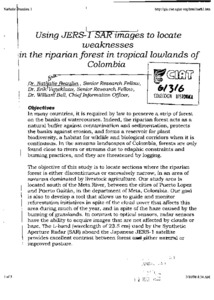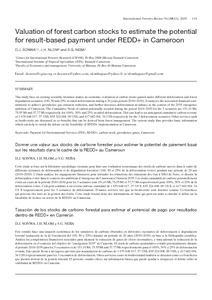The underlying causes of forest decline
Loggers, miners and rural communities all exploit forests in unsustainable ways in search of profits and means of subsistence. They are the primary actors in forest decline and their immediate motivations are the direct causes of deforestation and degradation. However, these motivations are determined, through complex causation chains, by deeper and much more fundamental forces: the underlying causes of deforestation. Effective action against forest decline requires an understanding of these underlying causes and their distant impacts on forests.
Unravelling the mysteries of the Quesungal Agroforestry System
Using JERS-1 SAR images to locate weaknesses in the riparian forest in tropical lowlands of Colombia
Valuation of forest carbon stocks to estimate the potential for result-based payment under REDD+ in Cameroon
This study base on existing scientific literature makes an economic evaluation of carbon stocks gained under different deforestation and forest degradation scenarios (100, 50 and 25% avoided deforestation) during a 20 years period (2010–2030). It analyzes the associated financial commitments to achieve greenhouse gas emission reduction, and further discusses deforestation avoidance in the context of the 2035 emergence ambition of Cameroon.
Vulnerability to climate change of cocoa in West Africa: patterns, opportunities and limits to adaptation
The West African cocoa belt, reaching from Sierra Leone to southern Cameroon, is the origin of about 70% of the world's cocoa (Theobroma cacao), which in turn is the basis of the livelihoods of about two million farmers. We analyze cocoa's vulnerability to climate change in the West African cocoa belt, based on climate projections for the 2050s of 19 Global Circulation Models under the Intergovernmental Panel on Climate Change intermediate emissions scenario RCP 6.0.
Water-resource and land-use issues
This paper reviews perceived notions of the relationships between catchment land use and hydrology and explores whether much of the widely disseminated folklore, so often inextricably linked with issues of land use, is based on myth or reality. Gaps in our knowledge of the underlying processes in relation to land use and hydrology are identified. Our ability to apply this knowledge at different scales ranging from the plot to the catchment and regional scales are discussed and specific examples are drawn from Indian and African case studies.
What is a REDD+ pilot?: a preliminary typology based on early actions in Indonesia
This infobrief provides an early snapshot of 17 REDD+ pilots under development in Indonesia in mid 2009. There is great variety in and experimentation by the proponents of REDD+ pilots. Three key dimensions useful for categorising early pilots are: 1) degree of spatial planning and heterogeneity of forest classification, 2) strategy for establishing long-term claims to carbon, and 3) predominant driver and agent of deforestation and degradation.
When the Dutch disease met the French connection: oil, macroeconomics and forests in Gabon
Gabon’s oil wealth coincides with the fact that it is one of the most forested countries in Africa; about four-fifths of its land area is covered by forests. But this is not really a coincidence. The central hypothesis of this report is that oil rents have enabled a series of pro-urban, anti-rural policies that, together with the low demographic pressure, have been key in protecting forests from degradation and deforestation. In particular, forest conversion to cropland has been contained. Most probably, oil has helped expand forest cover in absolute terms.
Uncertainty and Opportunity:
Most of the world’s remaining tropical forests lie in areas that are customarily managed and/or legally owned by Indigenous Peoples and local communities. In the context of climate change and global efforts to protect and enhance the capacity of forests to capture and store greenhouse gas emissions, the question of who owns the trees and the carbon stored therein is paramount. Clarifying this question is crucial, both for the future of the planet, and for up to 1.7 billion people worldwide who rely on forests for their livelihoods.
“Medium-Scale” Forestland Grabbing in the Southwestern Highlands of Ethiopia: Impacts on Local Livelihoods and Forest Conservation
Tropical forest provides a crucial portion of sustenance in many rural communities, although it is increasingly under pressure from appropriations of various scales. This study investigated the impacts of medium-scale forestland grabbing on local livelihoods and forest conservation in the southwestern highlands of Ethiopia. Data were generated through interviews, discussions and document review.
Over 5 years Africa has lost forests the size of England, this is how to create a trade-off
Deforestation remains a persistent environmental challenge in Africa. The Food and Agriculture Organization (FAO) estimates that between 2010 to 2015 alone, the continent experienced a net loss of around 17 million hectares of forests. To put this in perspective, this is equivalent to more than 1.3 times the total land size of England. It is also a major driver of carbon emissions







